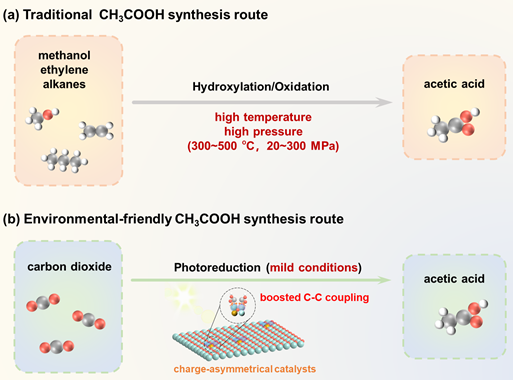《Angew. Chem. Int. Ed.》: Light-Driven C-C Coupling for Targeted Synthesis of CH3COOH with Nearly 100% Selectivity from CO2
Jinyu Ding,+ Peijin Du,+ Juncheng Zhu,+ Qing Hu, Dongpo He, Yang Wu, Wenxiu Liu, Shan Zhu, Wensheng Yan, Jun Hu, Junfa Zhu, Qingxia Chen,* Xingchen Jiao,* and Yi Xie*
Targeted synthesis of acetic acid (CH3COOH) from CO2 photoreduction under mild conditions mainly limits by the kinetic challenge of the C−C coupling. Herein, we utilized doping engineering to build charge-asymmetrical metal pair sites for boosted C−C coupling, enhancing the activity and selectivity of CO2 photoreduction towards CH3COOH. As a prototype, the Pd doped Co3O4 atomic layers are synthesized, where the established charge-asymmetrical cobalt pair sites are verified by X-ray photoelectron spectroscopy and X-ray absorption near edge spectroscopy spectra. Theoretical calculations not only reveal the charge-asymmetrical cobalt pair sites caused by Pd atom doping, but also manifest the promoted C−C coupling of double *COOH intermediates through shortening of the coupled C−C bond distance from 1.54 to 1.52 Å and lowering their formation energy barrier from 0.77 to 0.33 eV. Importantly, the decreased reaction energy barrier from the protonation of two*COOH into *CO intermediates for the Pd-Co3O4 atomic layer slab is 0.49 eV, higher than that of the Co3O4 atomic layer slab (0.41 eV). Therefore, the Pd-Co3O4 atomic layers exhibit the CH3COOH evolution rate of ca. 13.8 μmol g−1 h−1 with near 100% selectivity, both of which outperform all previously reported single photocatalysts for CO2 photoreduction towards CH3COOH under similar conditions.
Link: https://onlinelibrary.wiley.com/doi/abs/10.1002/anie.202400828


Figure 1. Schematic illustration for (a) traditional CH3COOH synthesis route at high temperature and pressure and (b) the designed environmentally friendly CH3COOH synthesis route form CO2 photoreduction under mild conditions.
